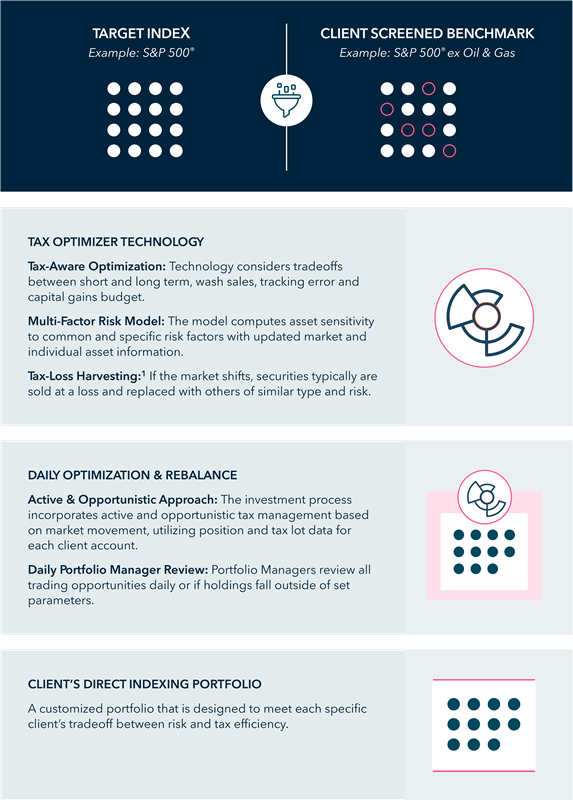
Brett Olsen
Direct Indexing has been popular for a select group of investors for decades. But thanks to recent advances, its potential benefits are more widely available.
Direct indexing (DI) is not a new concept, and many select investors have benefited from the investment approach for years. Historically, DI strategies were primarily available for high-net-worth investors whose large portfolios justified the costs and human resources required to manage portfolios in a customized manner. DI’s recent rise in popularity is largely due to investment managers’ ability to streamline and efficiently manage the process through technology at scale. This has resulted in lower operating costs, which has opened the door to more investors to explore direct indexing’s potential benefits.
What Exactly Is Direct Indexing?
Direct indexing involves buying a sample of the stocks that make up a specific index (e.g., the S&P 500®). Unlike traditional vehicles like exchange-traded funds (ETFs) or mutual funds, this approach gives clients direct ownership of the individual stocks and allows for customization specific to their initially stated preferences and goals. For most DI clients, these goals are centered on realizing tax benefits and customizing their portfolio based on any number of investment views.
An Example of Direct Index for Tax-Loss Harvesting

How Does Direct Indexing Work?
The portfolio largely aims to track the performance of the selected index. To set up a direct indexing portfolio, the investment manager:
1. Chooses an index. This choice is based on the overall investment plan as selected by the advisor or client.
2. Filters the stocks in the index, deciding which stocks to leave out and include. These decisions are based on the investment strategy goals.
3. Buys the chosen stocks. The investment manager uses portfolio optimization software to select a basket of securities with similar risk and return characteristics as the target index. The portfolio optimizer is a tool used to find the best allocation of assets given the investor’s objectives within specific risk and return constraints.
4. Systematically monitors the portfolio. The investment manager makes changes as needed, including buying and selling individual stocks as markets fluctuate with an objective to add after-tax benefit within the portfolio while maintaining market exposure.
What’s in It for the Client?
Potential tax benefits: With direct indexing, each client owns stocks at a different cost basis and during times of volatility in the market, the investment manager can sell stocks that have lost value and replace with stocks that provide similar exposure. This can help lower the taxes a client owes or offset gains in other investments. This is called tax-loss harvesting, and we’ll explore the process in greater detail later in the series.
Customization, personalization and diversification: An investment manager can make changes to a portfolio when an advisor’s clients’ needs or goals change. One example could be an executive of a large technology firm who may have a compensation package that includes shares of the company’s stock. This compensation would increase the executive’s exposure to the technology sector. Direct indexing would allow the executive to choose to hold fewer tech stocks than would than reflected within the index itself.
For other portfolios, the investment manager can help achieve the client’s goals by choosing not to buy certain stocks to reflect a client’s personal or mission-driven philosophies.
Is Direct Indexing Right for You?
Direct indexing gives advisors and their clients more control over their investments. Our Mellon investment experts can help determine whether a direct indexing strategy can complement your investment goals.
1There's no guarantee that a particular investor will realize significant tax benefits from harvesting gains or losses. Investment strategies that seek to employ tax management may be unable to fully realize strategic gains or harvest losses due to various factors. Market conditions and/or client account holdings may limit the ability to generate tax losses. Tax-loss harvesting involves the risks that the new investment could perform worse than the original investment and that transaction costs could offset the tax benefit. Also, a tax-managed strategy may cause a client portfolio to hold a security in order to achieve more favorable tax treatment or to sell a security in order to create tax losses. The ability to minimize tax consequences for a specific account may decrease as gains have the potential to accumulate over a period of time. Investors in lower tax brackets generally will not derive the same level of potential tax benefits from tax-managed strategies than those in higher tax brackets. Tax considerations, while important, are just one factor to consider before making any investment decision. Tax-managed investing and tax transitioning do not equate to comprehensive tax advice, are limited in scope and not designed to eliminate taxes in an account. Please consult your own tax advisor or financial professional for more detailed information on tax issues as they relate to your specific situation. Example shown is for illustrative purposes only and does not reflect actual results. The Standard & Poor's 500 (S&P 500) Index is a widely accepted, unmanaged index of US stock market performance. Investors cannot invest directly in an index.
PAST PERFORMANCE IS NOT NECESSARILY INDICATIVE OF FUTURE RESULTS.
All investments involve risk, including the possible loss of principal. Certain investments have specific or unique risks. No investment strategy or risk management technique can guarantee returns or eliminate risk in any market environment.
This material has been provided for informational purposes only and should not be construed as investment advice or a recommendation of any particular investment product, strategy, investment manager or account arrangement, and should not serve as a primary basis for investment decisions. Prospective investors should consult a legal, tax or financial professional in order to determine whether any investment product, strategy or service is appropriate for their particular circumstances. This document may not be used for the purpose of an offer or solicitation in any jurisdiction or in any circumstances in which such offer or solicitation is unlawful or not authorized. Views expressed are those of the author stated and do not reflect views of other managers or the firm overall. Views are current as of the date of this publication and subject to change. This information may contain projections or other forward-looking statements regarding future events, targets or expectations, and is only current as of the date indicated. There is no assurance that such events or expectations will be achieved, and actual results may be significantly different from that shown here. The information is based on current market conditions, which will fluctuate and may be superseded by subsequent market events or for other reasons. References to specific securities, asset classes and financial markets are for illustrative purposes only and are not intended to be, and should not be, interpreted as recommendations. Charts are provided for illustrative purposes and are not indicative of the past or future performance of any BNY product. Some information contained herein has been obtained from third party sources that are believed to be reliable, but the information has not been independently verified. No part of this material may be reproduced in any form, or referred to in any other publication, without express written permission.
Indices referred to herein are used for comparative and informational purposes only and have been selected because they are generally considered to be representative of certain markets. Comparisons to indices as benchmarks have limitations because indices have volatility and other material characteristics that may differ from the portfolio, investment or hedge to which they are compared. The providers of the indices referred to herein are not affiliated with Mellon Investments Corporation (MIC), do not endorse, sponsor, sell or promote the investment strategies or products mentioned herein and they make no representation regarding the advisability of investing in the products and strategies described herein. Investors cannot invest directly in an index.


